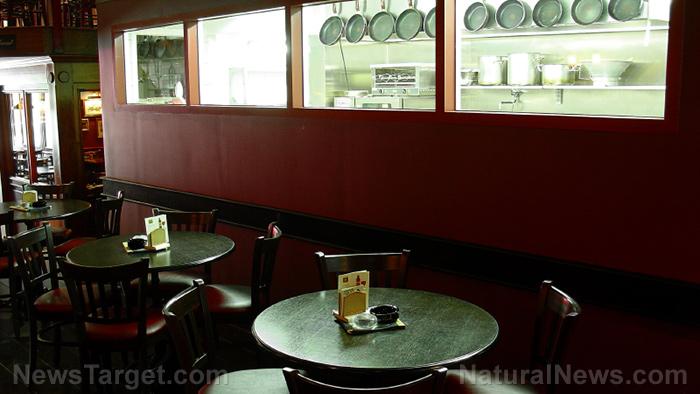
After more than two years of the Wuhan coronavirus (COVID-19) ravaging economies worldwide, many local restaurants all over the United States are still fighting for survival.
They have been hit hard by the pandemic and there's no sign the pounding on the kitchen, the dining room, outdoor patio or the cash register counter will ever stop. They will have to cope with rising prices of supplies, labor shortages and fewer customers.
No wonder over 110,000 eating and drinking establishments in the U.S. shut down – temporarily or permanently – last year, according to the National Restaurant Association (NRA). This has put the number of jobs lost to nearly 2.5 million.
In Tulsa, Ty's Hamburger owner Kristina Cushenberry said loyal customers have kept her business afloat, but every day poses new challenges.
Cushenberry told News9.com she wanted to hire two more people, but so far no one has responded to the "help wanted" sign hanging at her window for over a year. Sushi Hana owner Kenny Chan complained of the shortage of essential products like chopsticks or certain sauces, and when he manages to find them, "they're double or triple in price."
"Everybody is having a hard time right now because everything is so much more expensive – beef, chicken, vegetable – and then you can't get any guys to work and if they do come to work we have to pay them more to stay," said Chan.
The same situation and problems hound local restaurants in Delaware, according to WHYY News.
Restaurant industry has taken one of the worst economic beatings
"The state's restaurant industry has taken one of the worst economic beatings with about 10 percent of the 2,000 or so establishments shuttering their doors early on," said Carrie Leishman, head of the Delaware Restaurant Association.
If only to console restaurant owners in Oklahoma and Delaware, the majority of their counterparts in the other 48 states are reeling from the prolonged effects of the pandemic. In fact, total national sales in the industry for 2021 was only $659 billion, a huge $240 billion short of the projected $899 billion in sales.
According to the NRA, the industry is in a "free fall," citing its recent survey which saw 87 percent of full-service restaurants report an average of 36 percent decline in sales revenue. And worse, there's an 83 percent chance sales are going to dip further in the next three months. (Related: Restaurant Industry in Free Fall; 10,000 close in three months.)
Firefly, foodservice research firm Datassential's proprietary database, reported that 79,438 restaurants in the United States shut down in 2020, which is 10.2 percent of the total of 778,807 restaurants that were in operation when the pandemic broke out.
Food trucks were the hardest hit, with 22.5 percent of them removed from the road. As expected, quick-service restaurants which comprised the industry's largest segment, had the lowest percentage of closures at 9.8 percent. The largest food chains – those with more than 501 units – did better than independent restaurants and smaller chains.
"Every restaurant segment has been impacted by the pandemic, but the sales and employment losses have been felt disproportionately by full-service restaurants, which had much more challenging pivots to off-premises service," said Hudson Riehle, senior vice president of the NRA's research and knowledge group.
Lawmakers crossing party lines to help restaurant businesses recover
Lawmakers are crossing party lines to help the restaurant business recover. Senators Ben Cardin, a Democrat from Maryland, and Roger Wicker, a Mississippi Republican, had put together a $68 billion stimulus package proposal.
Cardin said lawmakers are looking at "how much is needed" for the second round of the restaurant rehabilitation fund, which should exceed the Restaurant Revitalization Fund of $28.6 billion from the American Rescue Plan offered by the White House in May 2021.
So, there's a glimmer of hope after all. Especially, if the COVID-19 scourge subsides.
If it does, columnist Emily Newton looks at the restaurant industry optimistically. In a guest opinion for foodsafetynews.com, Newton predicted mask-wearing and social distancing will fade with the virus.
She said handwashing stations and regular disinfection will continue, and so will the QR code-based menus and the app-based reservations.
Automated service will likely expand while the use of metallic nanoparticle coatings to sterilize kitchen equipment is a probability. Having undergone two years of slump and stagnation, the restaurants will survive and online deliveries will thrive.
More related stories:
Global supply chain crisis expected to last another TWO YEARS.
North American Meat Institute: Labor shortage plays key role in food inflation.
BREAKDOWN: Basic services and supply chains are rapidly breaking down all over the globe.
Watch the video below about the struggles of local restaurants.
This video is from the high impact Flix and more!!! channel on Brighteon.com.
Follow Pandemic.news for more news related to the coronavirus pandemic.
Sources include:
Please contact us for more information.


















